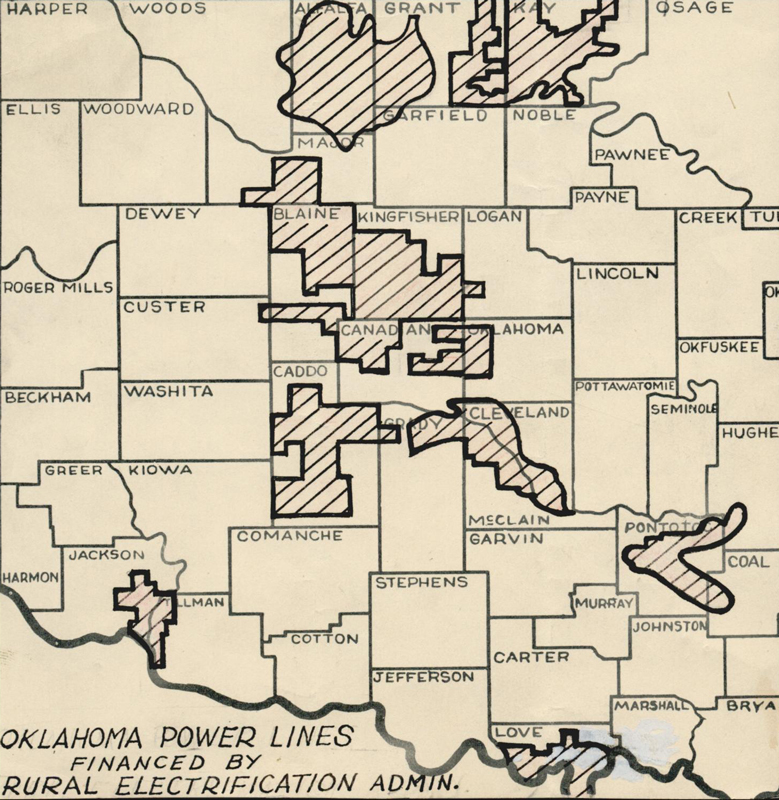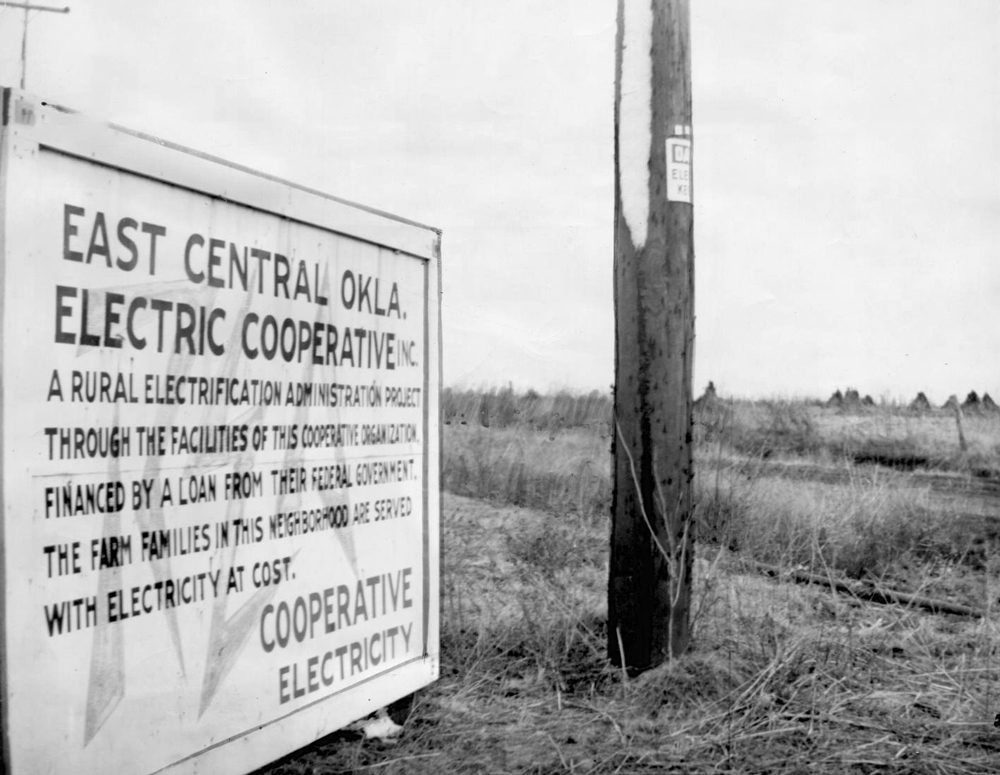Rural Electrification Act 1936 Signed by President Roosevelt on May 20 1936 the Rural Electrification Act enabled the federal government to make loansfor rural electrification and the furnishing of electric energy to persons in rural areas who are not receiving central station service. The funding was channeled through cooperative electric power companies hundreds of which still exist today.

Rural Electrification Changed Farm Life Forever In Wyoming Wyohistory Org
The situation was much better in the Northwest where 475 percent of the farms in Washington 275 percent of the farms in Oregon and 298 percent in Idaho had.

Why was the rural electrification administration formed. May 20 2016 is the 80 th anniversary of the Rural Electrification Act of 1936. In 1936 a group of farmers in Licking and Knox counties decided to take advantage of a federal program offered by the Rural Electrification Administration REA by forming an electric cooperative known as Licking Rural Electrification LRE. It allowed the federal government to make low-cost loans to non-profit cooperatives farmers who had banded together for the purpose of bringing electricity to much of rural America for the.
President Franklin Roosevelt established the Rural Electrification Administration REA under authority of the Emergency Relief Appropriation Act of 1935. These member-owned cooperatives purchased power on a wholesale basis. The focus for rural electrification projects is generally in African countries and the outskirts of developed countries.
By 1950 87 percent of farms had electrical service. At the time only 10 percent of the nations farms had electricity. Rural Electrification Act 1936 T he Rural Electrification Act 49 Stat.
Recognizing the need for rural electrification farmers farm organ-. It then channeled funding through these coops through low-interest loans to finance the construction of generation and distribution facilities and power lines to bring electricity to farms. In rural electrificationthe 20th century by the Rural Electrification Administration REA a federal agency established in 1935 under the New Deal in an effort to raise the standard of rural living and to slow the extensive migration of rural Americans to urban centres.
In developed countries electricity is considered the backbone of the economy and it is generally agreed that providing access to electricity is a key element in the fight against poverty and an enabler of. At inception five people were employed to service 410 members and 143 miles of electric line. Formed when the government assumes responsibility for providing for citizens needs.
The impact of electrification in such isolated areas was enormous. The TVA Act encouraged economic development and provided jobs by bringing electricity to rural areas for the first time. To administer the loans and monitor the progress of rural electrification the act.
Low energy rates would help to ensure affordable reliable power for all. The purpose of electrification is to make life easier for people living in rural areas and help them to be able to sustain themselves better. The Rural Electrification Act of 1936 enacted on May 20 1936 provided federal loans for the installation of electrical distribution systems to serve isolated rural areas of the United States.
The following November SCREA received its first loan of 542328 for the purpose of providing electrical power to rural residents. The REA was created to bring electricity to farms. On May 11 1935 Roosevelt signed Executive Order No.
REA funding and the work of the newly formed cooperatives transformed rural life. This program authorized by Congress in 1935 lent funds to rural cooperatives to generate and distribute electricity to areas not served by private utility companies. In 1936 a group of farmers in Licking and Knox counties decided to take advantage of a federal program offered by the Rural Electrification Administration REA by forming an electric cooperative known as Licking Rural Electrification LRE.
Member of the Black Cabinet. In 1942 half of US farms had electricity. 1363 was one of the most important pieces of legislation during the era of President Franklin D.
By the mid-50s most all of them did. Administration SCREA in March 1935. 7037 establishing the Rural Electrification Administration REA.
The developed world takes it for granted but it is a luxury to many parts of the developing world. Real sense the electrification of rural areas is of national concern not only because of its contributions to the comforts and income of the individual farm family but also because of its influence on the welfare of agriculture generally. The REA was created by the Roosevelt Administration in 1935 to bring electricity to rural areas.
The Rural Electrification Administration still exists today as the Rural Utilities Service under the US Department of Agriculture. The Rural Electrification Administration provided electricity to. One of the most important New Deal programs for farmers was the Rural Electrification Administration REA.
The REA or Rural Electrification Administration was creadted in 1935 by the Roosevelt administration to encourage farmers to create electricity coperative companies. Roosevelt was inspired to create the REA by observing the need for electricity on farms in Georgia. The Rural Electrification Act of 1936 enacted on May 20 1936 provided federal loans for the installation of electrical distribution systems to serve isolated rural areas of the United States.
It was a congressional endorsement of the Rural Electrification Administration which US. More than 98 percent of the United States farms. SCREA was created to borrow federal money to build lines in rural areas.
Accordingly the state government created the South Carolina Rural Electrification. The idea of providing federal assistance to accomplish rural electrification gained ground rapidly when President Roosevelt took office in 1933. The Rural Electrification Act was also an attempt made by FDRs New Deal to deal with high unemployment.
Roosevelt created by executive order in May 1935 as part of his New Deal during the Great Depression. In 1936 nearly 90 percent of farms lacked electric power because the costs to get electricity to rural areas were prohibitive. At inception five people were employed to service 410 members and 143 miles of electric line.

Rural Electrification The Encyclopedia Of Oklahoma History And Culture

Rural Electrification Changed Farm Life Forever In Wyoming Wyohistory Org

Rural Electrification Administration In Minnesota Mnopedia

Rural Electrification Administration In Minnesota Mnopedia

Running Water Poster Rural Electrification Administration Lester Beall Jpg 500 674 Pixels Japanese Poster Design Running Water Poster Design Layout

Print By Lester Beall Wpa Posters Design History Design

Rural Electrification Changed Farm Life Forever In Wyoming Wyohistory Org

Building Rea Electric Lines In The Great Depression

Lester Beall For The U S Department Of Agriculture 1930s Flashbak Rural Lesters Farm

Vintage Poster Our Lines Rural Electrification Administration U S Department Of Agriculture Beall Historic Wall Art In 2021 Historic Poster History Design Arts And Crafts Festival

Rural Electrification Administration In Minnesota Mnopedia

Home Vintage Graphic Design Vintage Poster Design Zine Design

Rural Electrification Administration Rea 1935 Living New Deal

Rural Electrification Administration Rea 1935 Living New Deal

Rural Electrification The Encyclopedia Of Oklahoma History And Culture

Rural Electrification Administration In Minnesota Mnopedia

Percentage Of Farms With Electricity The Electric Cooperative Program Began In 1935 When The Federal Rural Electrif Back In The Day Central Station Small Towns


